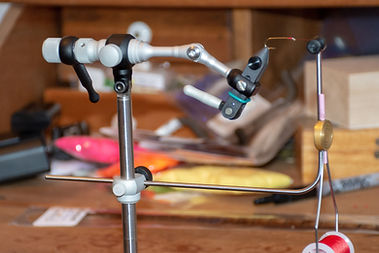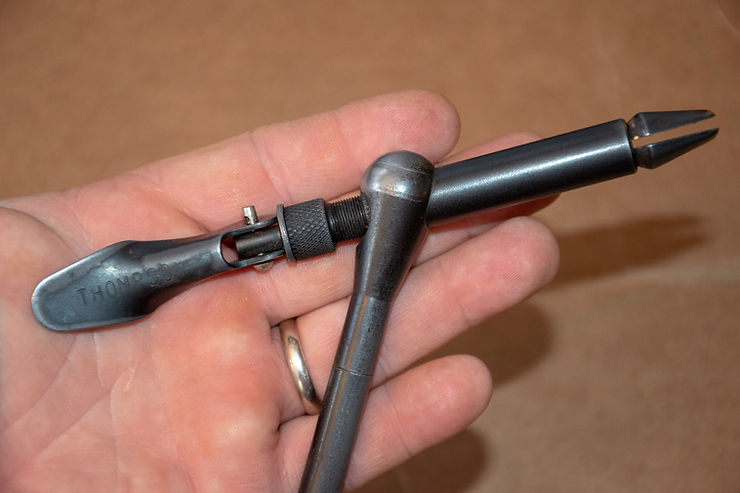Old Vise, New Vise: Upgrading to the Renzetti Presentation 2000 Series

After I’d been tying flies for about a year or so, I wanted to upgrade my vise. I remember walking into the local fly shop with a little bit of money in my pocket as the owner showed me a few that might be in my price range. I bought the most expensive one, a Thompson that cost a whopping $100.00.
Looking at it now, that vise was positively plain, but I remember feeling like I’d just bought a Cadillac. The greatest improvement between that vise and the one that came with the fly tying kit I’d purchased a year earlier, was the ease of adjustment. It held the hook firmer and did a great job on hooks down to size 22. A hundred dollars was all I had to my name at the time, but it was a worthwhile investment.
Twenty-five years later, and literally thousands of ties, it has finally worn out and is ready for retirement.
It’s hard to find anything that will last 25 years nowadays. Most items we use in our daily lives aren’t designed for long-term durability. Appliances are just one example. So I’d say that $100 was money well spent.
Shopping for a new vise was an interesting experience. There are still a number of plain, ordinary vises available to buy, but there are plenty that look more like “contraptions” than vises, and the more bells and whistles they have, of course, the more expensive they tend to be.
I ended up purchasing a Renzetti Presentation 2000 Series, and it’s the first rotary-style vise I’ve ever used. I bought it with the c-clamp to attach to my fly tying desk (rather than with the platform base) and that presented a slight problem. The c-clamp doesn’t close enough to attach to my desk. I had to use a strip of 1×2 spacer to attach to the desk, which is a fold-out table about an inch thick. It now works fine and is stable.

In the past two months, I’ve tied in the neighborhood of 3,000 flies on the old Thompson vise, and although I’ve only tied a few hundred so far on the Renzetti, I can tell you that tying flies is quicker and easier with the rotary vise, once you learn how to manipulate the arm to get the desired angles for the patterns you’re tying. When I set up the vise for a specific size and style of hook, I’ll usually knock out 30-40 of a certain pattern before switching to something else that might require a different adjustment. And make no mistake, I’m still getting used to making adjustments, fine tuning how I do things. In the future, I’ll get quicker at it, I’m sure, but I’m catching on and getting better every time I sit down to tie flies.
If you’ve never used a rotary vise, definitely consider purchasing one. You’ll be glad you did. But be warned: they’re not cheap. Although there are many vises that are much more expensive, this one cost about $340.00 including shipping. If it lasts me as long as that $100.00 Thompson vise did, I’ll be ecstatic.
Even still, there’s a little sadness when laying an old vise to rest. I’m a simple guy, and the Thompson was a simple vise. We were a perfect match. I’ll miss the worn smooth metal, worked so many times that the black coating has worn down to the polished metal.

A Brief History of Vises
The first vises fly tyers ever used were their fingers. After doing some research online, trying to figure out when the first fly tying vise was actually invented, I came across this passage written by Henry Wade in 1860:
“Take the bend of the hook between your left finger and thumb, the shank projecting; place an end of the waxed silk, which should be about six inches in length, and the end of the gut along the underside of the shank; pass the silk over until you have wrapped it down to the end of the shank, and two or three turns back for the head of the fly; take the feather or hackle as prepared, put the point of the feather from where it is turned back with the outside next the hook, and hold it there with your left finger and thumb until you pass the silk over it, just where you left off, wrapping it twice or thrice on its downward rounds to the bend of the hook; take your scissors and cut off the root of the feather, and the superfluous gut under the bend of the hook, leaving it not quite so long as the body of the fly has to be made; take the thick end of your feather in your tweezers or pliers and wrap it over three or four times close together, following the silk wrappings until it is all, or as much as you deem sufficient, twirled on; then take your silk and pass over the end once or twice; cut off the superfluous part of the feather and wrap up the shank with the silk, evenly and regularly, to form the body of the fly, and fasten off by a loop-knot or two; or, if you want a thick-bodied fly or one of flossed silk, turn down again and fasten off at the shoulder; cut off the silk left, set the feather right with your needle and finger and thumb, and the fly is made or dressed. This is the simplest method.” (From the book Rod-Fishing in Clear Waters By Fly, Minnow and Worm.)
It certainly doesn’t sound like the simplest method to me. I can’t imagine trying to tie a Rainbow Warrior, or some other complicated tie, while clamping the hook between my fingers. Apparently, this method isn’t as outdated as I thought, though. Several sources state that Lee Wulff tied flies this way. I also came across the book Tied in the Hand Salmon Flies by Sven-Olov Hard, although I’m uncertain when this book first appeared.
The most common flies tied “in hand” seem to be salmon flies and tenkara flies. Here’s a link to the Casting Around website in which John Geer of Tenkara USA ties a pattern in hand: Letting Go of Vices and Vises: Part 2 – Casting Around (anthonynaples.com)
Several sources indicate that the first mention of a vise designed specifically for fly tying was in the book Ogden on Fly Tying, published in 1887. Prior to that, I imagine fly tyers simply used other tools in a creative manner to get the job done. A basic c-clamp, for instance, or a pair of vise grips clamped in a…you guessed it, a vise. We’ve come a long way since then, and in this particular instance, that’s definitely a good thing.
Sign up for the Dark Skies Fly Fishing e-newsletter
It's free, delivered to your inbox approximately three times each month. Your information is always kept private and used for the sole purpose of keeping you up to date on blog posts and specials in the online store.
Sign Up Now
Should of got a Norvise